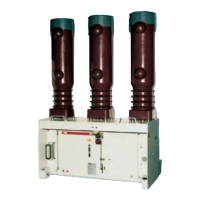21
Note:
Use only halogen free cleansers, and in no case
1.1.1-trichloroethane, trichloroethylene or carbon
tetrachloride!
7.3.2 Stored-energy spring mechanism
(Figures 7/1 to 7/4)
Servicing of the operating mechanism is to be
performed after the following number of operating
cycles:
• Breakers with rated short-circuit breaking cur-
rents up to 50 kA after 10,000 operating cycles.
• Breakers with 63 kA rated short-circuit breaking
current after 5,000 operating cycles.
Prior to servicing, switch the breaker off, and
• move it out of the panel (with withdrawable
breakers) or
• isolate the outgoing feeder (with stationary
mounted breakers).
Observe the safety regulations.
Details of the servicing:
• Switch off the charging motor (if fitted), and
discharge the spring energy store by closing
and opening the breaker once.
• Replace parts subject to high climatic and
mechanical stresses as a precaution.
• For replacing highly stressed parts neutralize
basic tension of the spiral spring, state the rate.
Be careful when carrying out!
• Relubricate pawls, support shafts, sliding and
rotating bearing surfaces. Lubricant:
Isoflex Topas NB 52.
• Check the fit of fasteners (e.g. locking pins) in
cranks, pins, bolts etc. Check the tightness
of fastening bolts.
• Always replace any spring lock washers, split
pins and other fasteners removed during the
work with new parts when reassembling the
equipment.
• Check the general condition of the operating
mechanism and recharge the spring energy
store.
• Perform comprehensive mechanical and
electrical functional tests.
• Observe the instructions on setting.
• Ensure that the bolted joints at the contact
locations of the conductor bar system and the
earthing connections are tight.
Note:
Above mentioned work may only be performed by
the after-sales service personnel of ABB or ade-
quately qualified personnel.
Prior to functional testing, switch the breaker off
and
• move it into the test position (withdrawable
breaker) or
• isolate the outgoing feeder (with stationary
mounted breakers).
Note:
Isolate and secure the working area in accor-
dance with the safety regulations specified by
DIN VDE/IEC.
Scope of functional testing:
• Perform several switching operations under no
load, above all with circuit-breakers seldom
operated in normal service.
• Switch off the charging motor (if fitted) and
discharge the spring energy store by ON/OFF
switching operations.
• Examine visual the condition of the lubrication on
rotary bearings, sliding surfaces, etc.
• Check the proper mechanical/electrical
sequence of the individual functions.
7.2.3 Breaker pole
No inspection of the breaker pole above and
beyond the stipulations of section 7.2.1 is
necessary.
7.3 Servicing
7.3.1 Switching devices in general
If cleaning is found to be necessary during
inspections as set out in 7.2.1, the following
procedure is to be adopted:
• Prior to cleaning, the working area is to be
isolated and secured against reclosing where
necessary in accordance with the safety
regulations of DIN VDE/IEC.
• Cleaning of surfaces in general:
– Dry, lightly adhering dust deposits with a soft,
dry cloth.
– More strongly adhering contamination with
slightly alkaline household cleanser or Rivolta
BWR 210.
• Cleaning of the insulating material surfaces and
conductive components:
– Light contamination:
with Rivolta BWR 210.
– Strongly adhering contamination:
with cold cleanser 716.
Wipe down after cleaning, using clean water,
and dry properly.
• Observe the manufacturer’s instructions and the
special ABB Instruction Manuals BA 1002/E or
BA 1006/E on safety at work.

